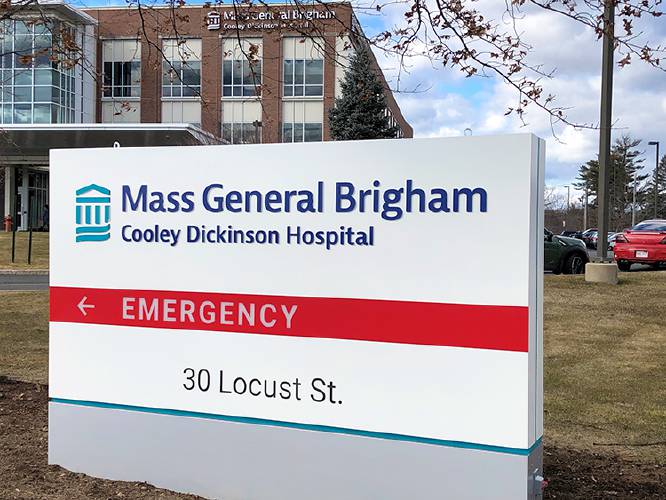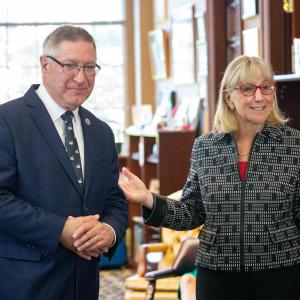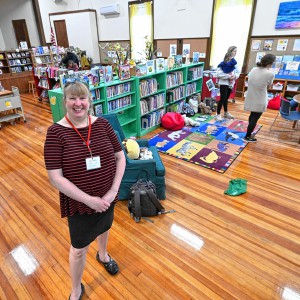Flu cases surge at Cooley Dickinson Hospital, while COVID, RSV less severe

A view of the front entrance sign for Cooley Dickinson Hospital in Northampton. GAZETTE FILE PHOTO
|
Published: 01-21-2024 12:11 PM
Modified: 01-22-2024 11:35 AM |
NORTHAMPTON — Even with less severe cases of COVID-19 than the past two years and a marked decrease since last fall in RSV, officially known as respiratory syncytial virus, a surge in flu cases is keeping Cooley Dickinson Hospital’s emergency department as busy as similar time periods in 2022 and 2023.
The increase in flu comes at the same time as another phenomenon is affecting CDH and other hospitals statewide — a space crunch on hospital beds. The problem is exacerbated by people staying too long and not being able to get into nursing homes or rehabilitation facilities in a timely manner, as well as the often thin staffing resources.
“We’re seeing about the same emergency department volume as in previous years and do see a higher proportion related to influenza,” says Dr. Sari Miettinen, chief medical officer at Cooley Dickinson, describing what she observes as “very high flu levels.”
Between Jan. 1-15, the hospital had about 1,500 ED visits, on par with 2023, and up from the 1,235 in 2022. About 9% of the ED visits this year were related to a respiratory illness, just like in 2023, but down from 14% two years ago.
The numbers statewide are similar. The Department of Public Health’s acute respiratory disease data dashboard gives some indication of what hospitals and providers are facing as COVID-19, the flu and RSV spread rapidly following the holiday gathering season.
There were about 66,975 emergency department visits in Massachusetts between Dec. 31 and Jan. 6, according to the most recent data from DPH. The number of ED visits is up slightly compared to the same week in previous years. For example, the same week one year earlier saw roughly 65,240 ED visits and the same week two years ago saw about 64,000 ED visits.
But respiratory illnesses are a less-significant part of the case mix this year than in the last two. Of the 66,975 ED visits the week of Dec. 31, 17.2% were related to a respiratory illness like COVID, flu or RSV. Respiratory illnesses accounted for 19.8% of ED visits one year ago and 29.8% of visits two years ago, according to DPH data.
Statewide hospital admissions, meanwhile, were up slightly during the week from Dec. 31 to Jan. 6. Of the 14,788 admissions, 21% were because of a respiratory illness including COVID, flu and RSV, according to DPH data.
Article continues after...
Yesterday's Most Read Articles
Those numbers also jibe with what Cooley Dickinson is seeing.
During the first two weeks of 2024, 22% of hospital admissions at Cooley Dickinson were because of a respiratory illness. The number of admissions was about the same as last year, at 20%, but down from the 27% two years ago.
While there has been an RSV decrease from fall, COVID has remained high and steady, Miettinen said, though those cases are generally less severe than in 2022 and 2023.
“The severity of illnesses compared to the last two years is lower,” Miettinen said. With community hospital level care, Miettinen said everyone is evaluated and stabilized and determined if they can be treated there or will need to go to another hospital.
Miettinen is advising people to use precautions to stay healthy, including getting vaccines for COVID and flu, washing hands regularly, wearing masks and face coverings when in crowded places and staying at home when sick.
This is identical to the advice from the Massachusetts Medical Society President Dr. Barbara Spivak.
“It is not too late in the season to get vaccinated against the flu and to get the most updated COVID-19 vaccines, and we urge people to contact their health care provider to schedule an appointment to do so as soon as possible,” Spivak said.
“Transmissible diseases may be a nuisance over the course of a few days and not trigger serious symptoms in most healthy people, but it is critically important to take every available measure to protect those among us who are most vulnerable,” Spivak said.
Meanwhile, to alleviate the capacity issues in its ER, Cooley Dickinson is relying on a new voluntary, though temporary, strategy being supported by the state. Health and Human Services Secretary Kate Walsh announced last week that hospitals, nursing homes, insurers and state regulators in Massachusetts have banded together to adapt operations in an attempt to ease some of this capacity problem.
The Massachusetts Health & Hospital Association said in a newsletter that Walsh outlined the agreement in a memo that also was sent to the Massachusetts Association of Health Plans, Blue Cross Blue Shield of Massachusetts, Massachusetts Senior Care Association, LeadingAge Massachusetts and Steward Health Care.
“Placement into long-term care facilities is definitely a challenge in the Valley,” Miettinen said.
Miettinen said that the capacity crunch is a statewide issue and is anticipated in Hampshire, Franklin and Hampden counties due to multiple closures and fewer long- and short-term beds in skilled nursing facilities.
Not waiting for prior authorization from member insurers, which can take from 72 hours to five days, is one part of the solution.
“This helps them to get to the right place at the right time,” Miettinen said, and will also free up beds for those who don’t need the acute hospital care.
Cooley Dickinson is also extending case management services until 6:30 p.m. daily.
MHA said the “well-documented patient ‘throughput’ problem is the result of many issues, from workforce shortages that have taken available beds offline, to the difficulty in transporting patients, to delays in getting the proper authorizations for the transfers.”
In a Jan. 9 memo, Walsh wrote: “The Massachusetts healthcare system continues to face severe capacity challenges as we navigate through the winter months with record hospital occupancy levels, three prevalent viruses circulating, and significant workforce shortages. These issues exist across the system and require immediate, short-term action on all parts to release pressure in the system and support timely patient transitions to the most appropriate care setting.”
Under the agreement, BCBSMA and MAHP member insurers will waive prior authorization for admissions from acute care hospitals to post-acute care facilities until April 1, hospitals have agreed to start patient discharge planning as early in the day as possible and will “seek innovative ways” to improve staffing so that all of their licensed medical/surgical beds can be put into use with patients, and nursing homes agreed to extend their admission hours to at least Monday through Saturday from 9 a.m. to 7 p.m.
Last month, MHA released a report showing that about 750 patients were stuck in acute or post-acute care hospitals on any given day in November as they waited to be either transferred to skilled nursing or rehabilitation facilities, or to get care from home health agencies. Just more than 200 patients waited 30 days or longer to be discharged to a skilled nursing facility, MHA said.
Steve Walsh, president and CEO of MHA, applauded Kate Walsh and the other organizations participating in the agreement, and said that easing prior authorization requirements could be “an especially powerful tool” for hospitals to keep patients moving along.
“The Massachusetts healthcare community has proven time and again that it can and will come together cooperatively to benefit the patients who rely on it,” he said.
“This recent voluntary agreement, which comes at the busiest time of year for healthcare providers, is yet another example of that cooperation.”
Material from the State House News Service was used in this report. Scott Merzbach can be reached a smerzbach@gazettenet.com.

 State Senate budget funds free community college for all
State Senate budget funds free community college for all ‘We can just be who we are’: Thousands show support for LGBTQ community at Hampshire Pride
‘We can just be who we are’: Thousands show support for LGBTQ community at Hampshire Pride Doors open at Tilton Library’s temporary home at South Deerfield Congregational Church
Doors open at Tilton Library’s temporary home at South Deerfield Congregational Church Area property deed transfers, May 2
Area property deed transfers, May 2
